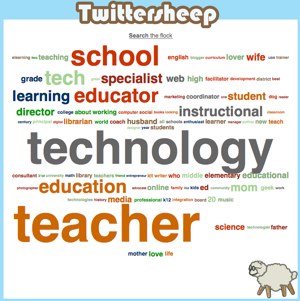 I had one of those singular experiences last night, which, as often happens, began with a simple request to do something that initially sounded simple, from a friend who is far from…
I had one of those singular experiences last night, which, as often happens, began with a simple request to do something that initially sounded simple, from a friend who is far from…
My friend, Kevin Jarrett, with whom I presented last year at an administrators conference in New Jersey, wrote a while back asking if I would appear in Second Life™ for an ISTE event. Well I can appear in Second Life just fine. It involves wisps of smoke and thunder — though you can’t really hear the thunder.
I agreed, only to learn later that this was a pretty involved, organized, and very well scripted affair — ISTE Eduverse Talks, done through a partnership between ISTE (International Society for Technology in Education) and SLCN.TV, a virtual television network in Second Life. I knew that this was serious (more serious than I usually plan to be) when they wanted to make an appointment at the studio for a sound check the week before.
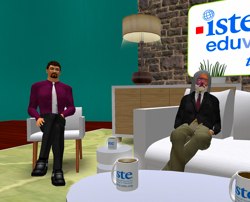 |
| Kevin & Me posing for the virtual camera (link) |
|
 |
| At least, no one was openly blogging from the front row — though I suspect that there were a lot of stiff left knees (link) |
|
 |
| You may be able to tell that I tatoo’ed my virtual face with a picture of my real face. The nose just doesn’t seem to fit well. (link) |
|
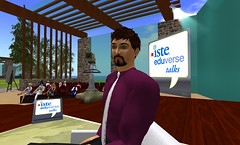 |
| Kevin looking sharp (link) |
|
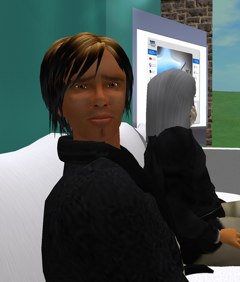 |
| I’m pretty sure that Steve bought his hair. (link) |
|
Not one to keep the fun to himself, I recommended Steve Dembo as another guest for the show, and he took it all in stride. I, on the other hand, always get nervous when someone says, “You’re on in ‘3’ ‘2’ ‘1’…”

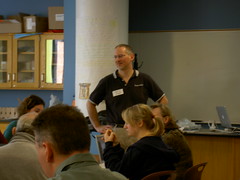 |
| Steve Dembo with son & Kevin Jarrett at Educon… |
|
Kevin was the host, and I have to say that he looked good in his maroon shirt, white tie, and virtual biceps. During the event, he, for some reason, wasn’t rez’ing on my display, and so all I saw was a gray outline with two glowing eyes — kind’a spooky.
Questions concerned a recent article on personal learning networks (pdf), that I wrote for Learning & Leading, and some of my earliest experiences with virtual worlds, MUDs and MOOs (MUSEs, MUSHes, etc.) Steve then came in with conversations about his work with Discovery Educator Network and their community building successes.
We closed speculating together about the future of virtual worlds, especially in education. My take is that we probably haven’t imagined it yet — what this is all going to become. I am convinced, however, that it isn’t going to replace anything.
I am also pretty sure that what ever the future holds, it will happen as a result from an intersection between our students’ experiences with these worlds out side the classroom, and our experiences as teachers, curriculum developers, and caring, creative adults. It will happen with our openness to their perspectives.
Tags: warlick, education, technology, elearning, virtualworlds, iste, eduverse talks, slcn.tv
